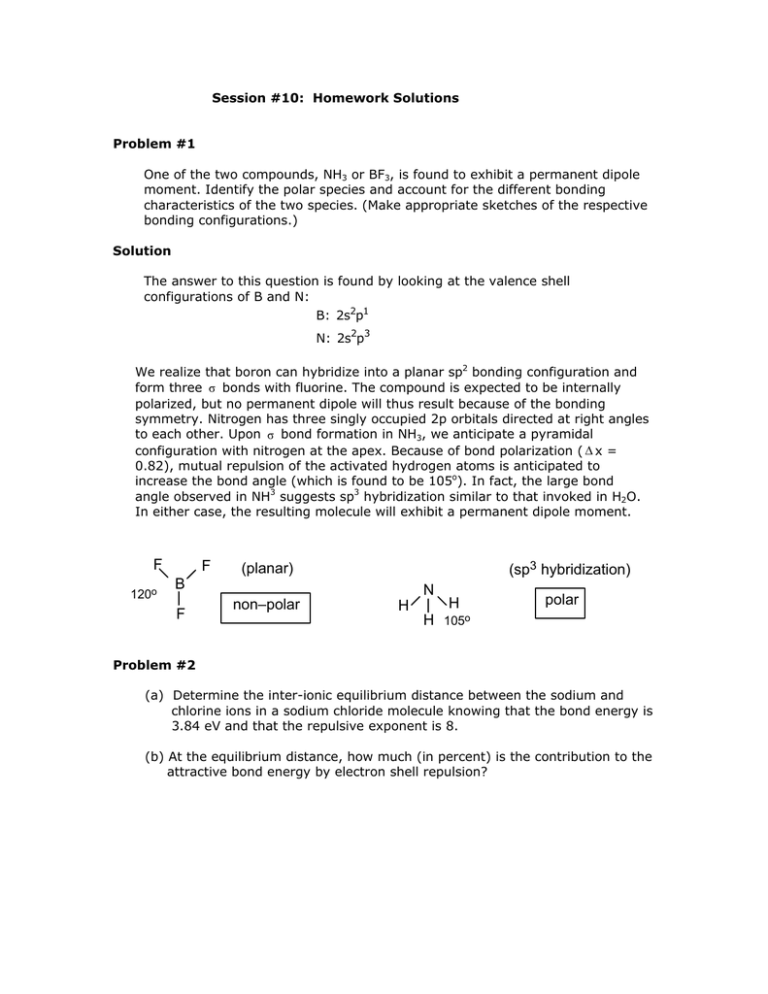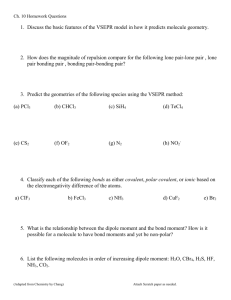Session #10: Homework Solutions One of the two compounds, NH
advertisement

Session #10: Homework Solutions Problem #1 One of the two compounds, NH3 or BF3, is found to exhibit a permanent dipole moment. Identify the polar species and account for the different bonding characteristics of the two species. (Make appropriate sketches of the respective bonding configurations.) Solution The answer to this question is found by looking at the valence shell configurations of B and N: B: 2s2p1 N: 2s2p3 We realize that boron can hybridize into a planar sp2 bonding configuration and form three σ bonds with fluorine. The compound is expected to be internally polarized, but no permanent dipole will thus result because of the bonding symmetry. Nitrogen has three singly occupied 2p orbitals directed at right angles to each other. Upon σ bond formation in NH3, we anticipate a pyramidal configuration with nitrogen at the apex. Because of bond polarization ( Δ x = 0.82), mutual repulsion of the activated hydrogen atoms is anticipated to increase the bond angle (which is found to be 105o). In fact, the large bond angle observed in NH3 suggests sp3 hybridization similar to that invoked in H2O. In either case, the resulting molecule will exhibit a permanent dipole moment. F 120o F (sp3 hybridization) (planar) B F N non–polar H H H polar 105o Problem #2 (a) Determine the inter-ionic equilibrium distance between the sodium and chlorine ions in a sodium chloride molecule knowing that the bond energy is 3.84 eV and that the repulsive exponent is 8. (b) At the equilibrium distance, how much (in percent) is the contribution to the attractive bond energy by electron shell repulsion? Solution (a) Eequ = -3.84 eV = -3.84 x 1.6 x 10-19 J = - ro = (1.6 x 10-19 )2 -12 4π8.85 x 10 -19 x 6.14 x 10 (1 - e2 1 (1 - ) 4πεoro n 1 ) = 3.3 x 10-10m 8 (b) Shell “repulsion” obviously constitutes a “negative” contribution to the bond energy. Looking at the energy equation we find: the attractive term as: the repulsion term as: –E x (1) = –E –E x (–1/n) = E/n = E/8 The contribution to the bond energy by the repulsion term = 1/8 x 100 =12.5%. (Since the bond energy is negative, the 12.5% constitute a reduction in bond strength.) Problem #3 Boron (B) reacts with bromine (Br2) to form a compound which is not polar (does not have a dipole moment). (a) Give the compound formed in Lewis notation. (b) List all bonding orbitals which on orbital overlap lead to the formation of this compound. (c) Do you expect the compound to exhibit a dipole moment or not? Why? Solution B: 1s2 2s2 2p1 Br: [Ar] 4s2 3d10 4p5 (a) If B shares its 2p1 electron with Br’s 4p5 shell, they will both obtain somewhat stable valence shells. However, BBr would be polar. If B hybridizes and its electron shell changes to 1s ↑↓ ↑ 2sp2 ↑ ↑ 2p then the B can bond with 3 Br. BBr3: 3(sp2–p overlap) σ bonds The symmetry of the hybridized (planar) molecule leads to coincidence of the centers of + and – charges –– the molecule, in spite of three polar covalencies, does not exhibit a dipole moment. (b) 1s ↑↓ 2s ↑↓ → 1s ↑↓ 2s ↑ → 1s ↑↓ 2sp2 ↑ ↑ ↑ 2p ↑ ↑ 2p ↑ 2p “p” Br (sp2–p) B Br (c) Br (sp2–p) All three bonds are based on sp2 orbital overlap, leading to the formation of σ bonds. MIT OpenCourseWare http://ocw.mit.edu 3.091SC Introduction to Solid State Chemistry Fall 2009 For information about citing these materials or our Terms of Use, visit: http://ocw.mit.edu/terms.



